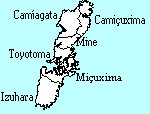Çuxima Province
| Capital | Izuhara (厳原市) |
| Governor | Maçumura Yoxiyuqui (松村良幸) |
| Area | 319.76 SI mi² |
| Establishment | Saisei 50 (2001) |
Çuxima (津島県, Çuxima-quen, formerly written 対馬) is a province in the Quiùxù region of Yamato. It is the newest province of Yamato, having been split off of Nagasaqui Province in Saisei 50 (2001), shortly after the opening of the Japan-Corea Tunnel. It consists of the Çuxima Islands.
History
Çuxima was one of the old lands of Japan prior to the Meidji Restoration. It is located about halfway between mainland Japan and Corea, and historically has played a significant role in trade between the two nations.
The early inhabitants are believed to have been Japanese. It has been a province of Japan since ancient times, although some of the early inhabitants may have come from Baikche, one of the former kingdoms in modern-day Corea. Though sparsely populated, they have been a key trading port, with both Japan and Corea influencing them. The islands were invaded in 1281 by the Mongols on their way to attempting invasion of Japan. The islands became a haven for pirates, and in 1419, King Sejoñ of Corea sent an invasion force to clear the islands of pirates. No attempt at colonization or administration was made.
During Toyotomi Hideyoxi's failed invasion of Corea, the islands formed a base of operations.
During the Tocugawa Xogunate, the daimiò of the islands carried out trade on behalf of the Xògun between Japan and Corea. During the Meidji Era, the islands were fully incorporated into Japan, and integrated into the province of Nagasaqui.
During the First Russo-Japanese War, the islands were the scene of the Battle of Çuxima, wherein the Japanese naval forces crushed the Russian fleet.
After the unification of Corea and Japan, the islands grew in importance due to trade between Yamato and Corea. Moves to separate it off as a distinct province grew after the establishment of the Japan-Corea Tunnel. The islands have become famous as a place where Corean and Japanese cultures meld. The population remains low, but has been growing in recent years.
ATOE's proposed space station will be named the Çuxima. Like the province of the same name, the space station is expected to be a place where Louisianne and Japanese cultures may mix. Also like the province, the station will be a key waypoint on the path to the Moon and beyond.
Administration
Çuxima contains one city (Izuhara), and five towns divided among two districts.
- Camíagata
- Camíagata
- Camiçuxima
- Mine
- Ximoagata
- Miçuxima
- Toyotama
The city of Izuhara was formerly part of Ximoagata district. There is currently talk among the towns of Camíagata and Camiçuxima of merging to form a new town to be called Camixima.
Geography
The islands of Çuxima are divided by a deep sound (Asò-wan). The southern section has two hills, Yatatxi-yama and Xira-daque, 2130 ft. and 1680 ft. high respectively, while the northern section has Ibexi-yama and Mi-taque, whose heights are 1128 ft. and 1598 ft.
| |||
|---|---|---|---|
| Regions of Yamato | |||
| Tòhocu | Cantò | Txùbu | Quiñqui | Txùgocu | Xicocu | Quiùxù | |||
| Provinces of Yamato | |||
| Aitxi | Aomoli | Aquita | Cagawa | Cagoxima | Canagawa | Còtxi | Cumamoto | Çuxima | Edo | Ehime | Fucúi | Fucúoca | Fucuxima | Guifu | Gumma | Hiògo | Hiroxima | Ibaraqui | Ixicawa | Iwate | Mie | Miyagui | Miyazaqui | Nagano | Nagasaqui | Nara | Nìgata | Ocayama | Òita | Òsaca | Quiòto | Saga | Saitama | Tocuxima | Tottoli | Totxigui | Toyama | Txiba | Wacayama | Xiga | Ximane | Xizúoca | Yamagata | Yamagutxi | Yamanaxi |
